Dr. Yen-Con Hung, also introduced the group to a new web site that is being developed during the Hot Topics Seminar. This web site, Peanut Information Network System (PINS), will be one central place to find peanut organizations, peanut related publications, research results and training materials. The material on the Web site which is funded through USAID Peanut CRSP Project will be organized in three categories focusing on the producer, processor and consumer. The producer section will contain information useful for peanut farming and will contain information on agronomics and fertilization, diseases, pest management, irrigation, peanut drying and harvesting, peanut grading and testing as well as peanut storage. The processor section contains information on aflatoxin management, processing and sensory qualities, postharvest handling and storage, value added products and biodiesel. The consumer section highlights recipes, nutrition and health information and information on peanut allergies. Check out the new web site at www.worldpeanutinfo.com or www.ugapeanuts.com. The site is not available yet so check back often.
2008 Georgia Peanut Tour
Tasting of New Peanut Products
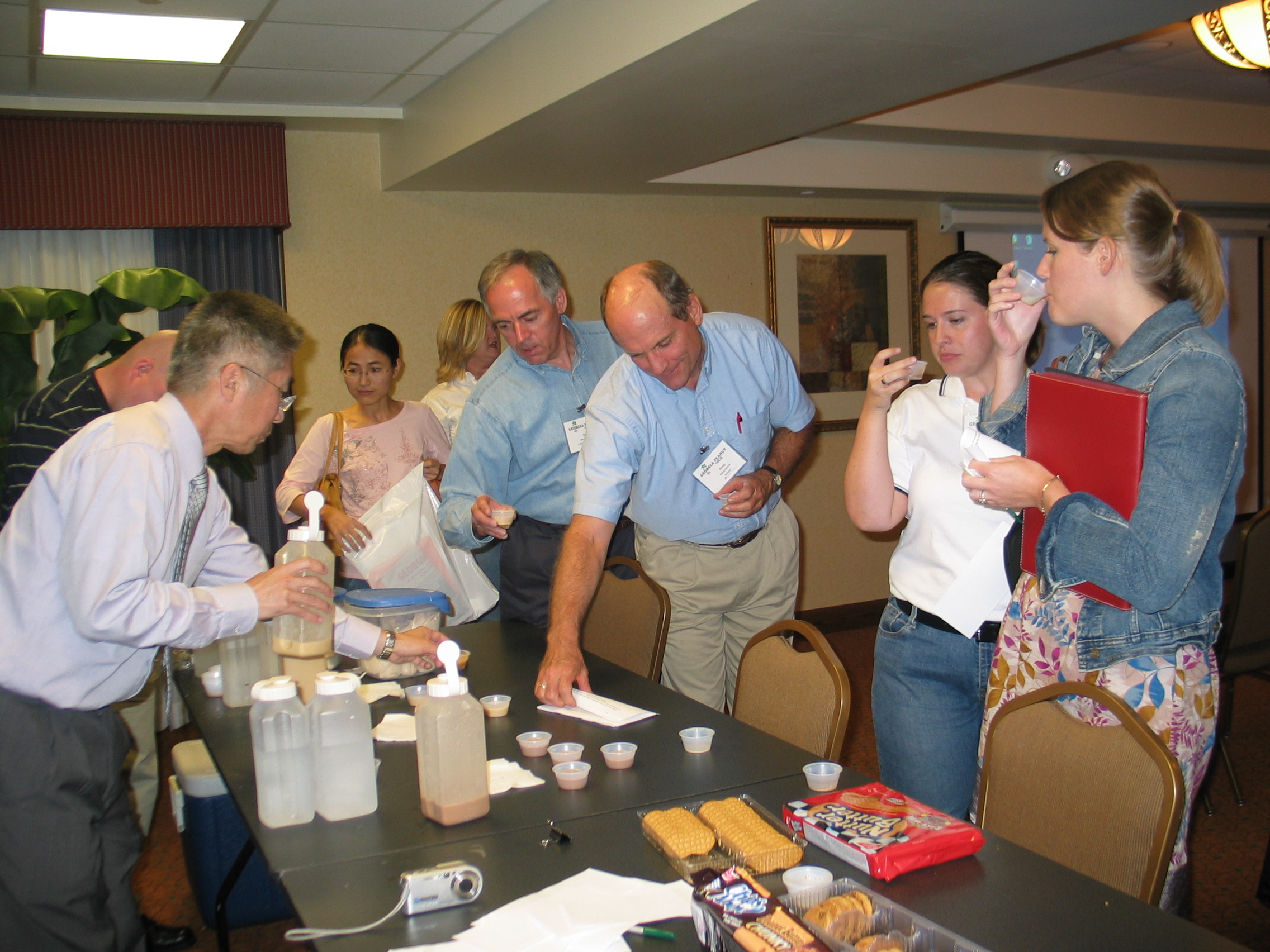 The University of Georgia Department of Food Science on the Griffin Campus has been busy developing new peanut products for Georgia Peanut Tour attendees to taste. During the Hot Topics Seminar on Tuesday, Dr. Yen-Con Hung and Dr. Manjeet Chinnan presented information on the Peanut Tart and the Peanut Shake Beverage Mix. This is not the first time that attendees on the Georgia Peanut Tour have been able to sample newly developed peanut products. A couple of years ago researchers brought samples of peanut butter tarts and peanut butter chips and peanut butter pasta for attendees to taste. Those sampling the products were asked to complete a short questionnaire on the product and evaluate their liking of the product. So far the responses have helped the researchers’ fine tune their products. The Department of Food Science Food Product Innovation and Commercialization (PIC) Program continues to assist companies in developing new food products.
The University of Georgia Department of Food Science on the Griffin Campus has been busy developing new peanut products for Georgia Peanut Tour attendees to taste. During the Hot Topics Seminar on Tuesday, Dr. Yen-Con Hung and Dr. Manjeet Chinnan presented information on the Peanut Tart and the Peanut Shake Beverage Mix. This is not the first time that attendees on the Georgia Peanut Tour have been able to sample newly developed peanut products. A couple of years ago researchers brought samples of peanut butter tarts and peanut butter chips and peanut butter pasta for attendees to taste. Those sampling the products were asked to complete a short questionnaire on the product and evaluate their liking of the product. So far the responses have helped the researchers’ fine tune their products. The Department of Food Science Food Product Innovation and Commercialization (PIC) Program continues to assist companies in developing new food products. View the UGA Department of Food Science Food PIC Web site.
Good Country Cooking
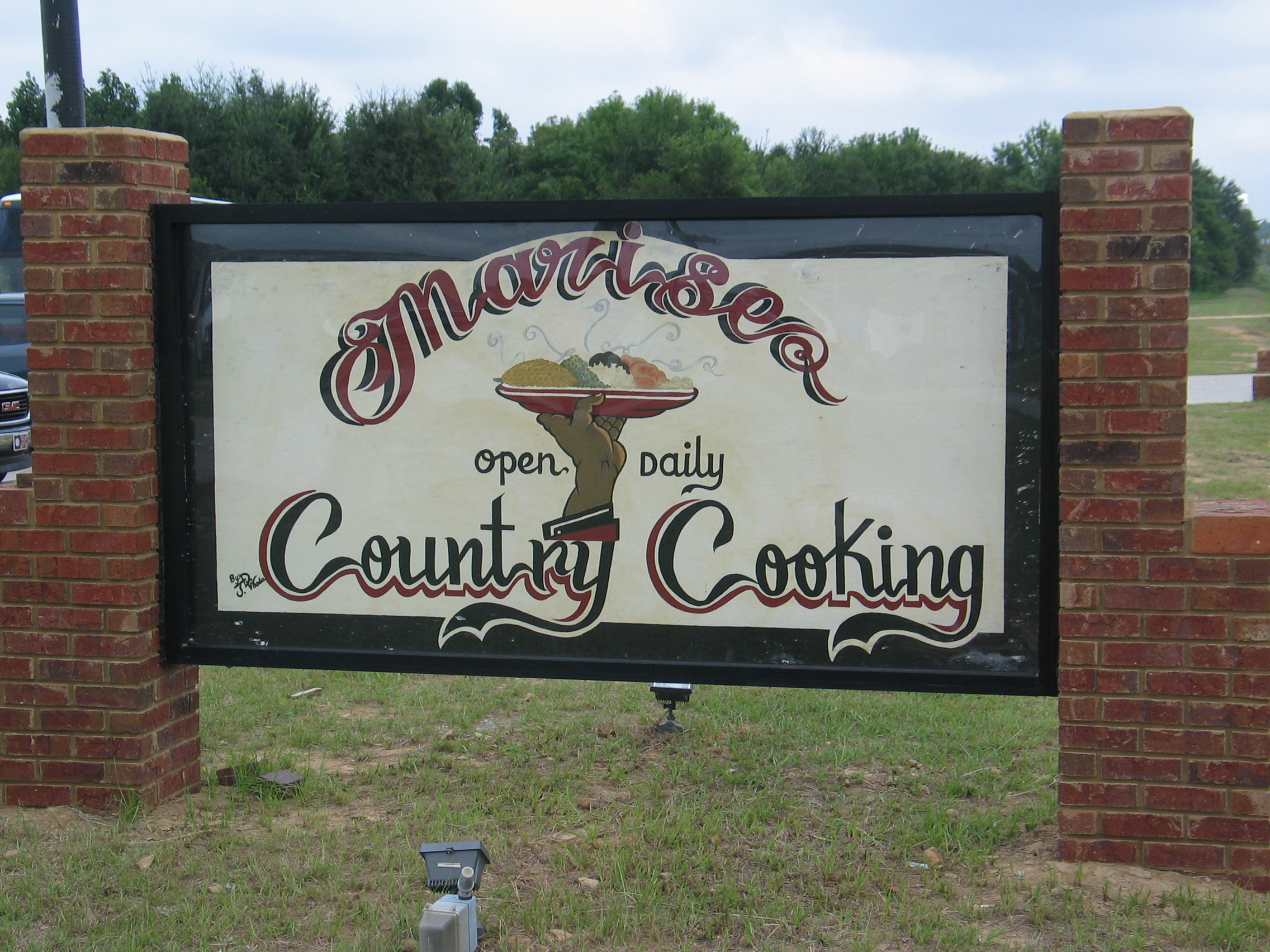 In addition to all the great tour stops at peanut farms, research centers and shelling plants the Georgia Peanut Tour is also known for great Southern hospitality and good country cooking. This year is no different. Tour attendees were able to sample boiled peanuts, fried quail, barbecue, fried chicken, a low country boil and peanut butter icecream. One stop on the tour was at Marise’s Country Cooking in Vienna, Ga. This restaurant is owned by the mayor’s wife, Marise. At this restaurant attendees had their choice of fried chicken, beef tips and rice, black eyed peas, collard greens, corn, fresh tomatoes, corn bread or biscuits. Desserts were also a big hit! Options included sweet potato pie, pecan pie, red velvet cake, chocolate cake, apple pie and the list goes on. So, next time you are passing by the area be sure to stop in. The restaurant is located off of Interstate-75 at Exit 109. You will be impressed by the food and great Southern hospitality!
In addition to all the great tour stops at peanut farms, research centers and shelling plants the Georgia Peanut Tour is also known for great Southern hospitality and good country cooking. This year is no different. Tour attendees were able to sample boiled peanuts, fried quail, barbecue, fried chicken, a low country boil and peanut butter icecream. One stop on the tour was at Marise’s Country Cooking in Vienna, Ga. This restaurant is owned by the mayor’s wife, Marise. At this restaurant attendees had their choice of fried chicken, beef tips and rice, black eyed peas, collard greens, corn, fresh tomatoes, corn bread or biscuits. Desserts were also a big hit! Options included sweet potato pie, pecan pie, red velvet cake, chocolate cake, apple pie and the list goes on. So, next time you are passing by the area be sure to stop in. The restaurant is located off of Interstate-75 at Exit 109. You will be impressed by the food and great Southern hospitality!
Intensive Peanut Management in Pulaski County

Ronnie Barentine, Pulaski County Extension Coordinator, Rodney & Gary Dawson, Pulaski County farmers, and Emily Evans, scout for farmers in Pulaski County.
While in Pulaski County, Georgia Peanut Tour attendees learned about the Peanut Intensive Management program farmers are utilizing to provide total production management. Ronnie Barentine, Pulaski County Extension Director, developed the concept to help farmers in his area. Peanuts contribute $7 million to farm income in Pulaski County each year. There are 8,000 acres of peanuts grown in Pulaski County with a production of 12,000 tons. The primary crops grown in the county are cotton, peanuts and corn. This year farmers have been faced with the drought, high temperatures and high energy costs. Farmers in Pulaski County have utilized the Peanut Intensive Management Program since 2002 on 18,000 acres. The program involves the use of computer programs and integrated pest management to assist growers with management decisions. Computer programs consist of Irrigator Pro, Harv-Pro and AU Peanut and assist the farmers with irrigation scheduling, timely harvest decisions and scheduling fungicide applications. The Integrated Pest Management consists of scouting fields for weeds, insects and disease. Farmers in the area have also hired the services of Emily Evans in scouting their peanut fields. She is the eyes for them in the field when looking for insect or disease problems and enters information such as soil temperature to help with scheduling irrigation.
The program is working and grower testimonials indicate yield increases of 275 pounds. According to Barentine, the value of the program is $1.3 million to farmers in Pulaski County. By utilizing the AU Peanut Model farmers have been able to reduce the number of fungicide applications thus saving them some expense on the farm.
Growing Organic Peanuts
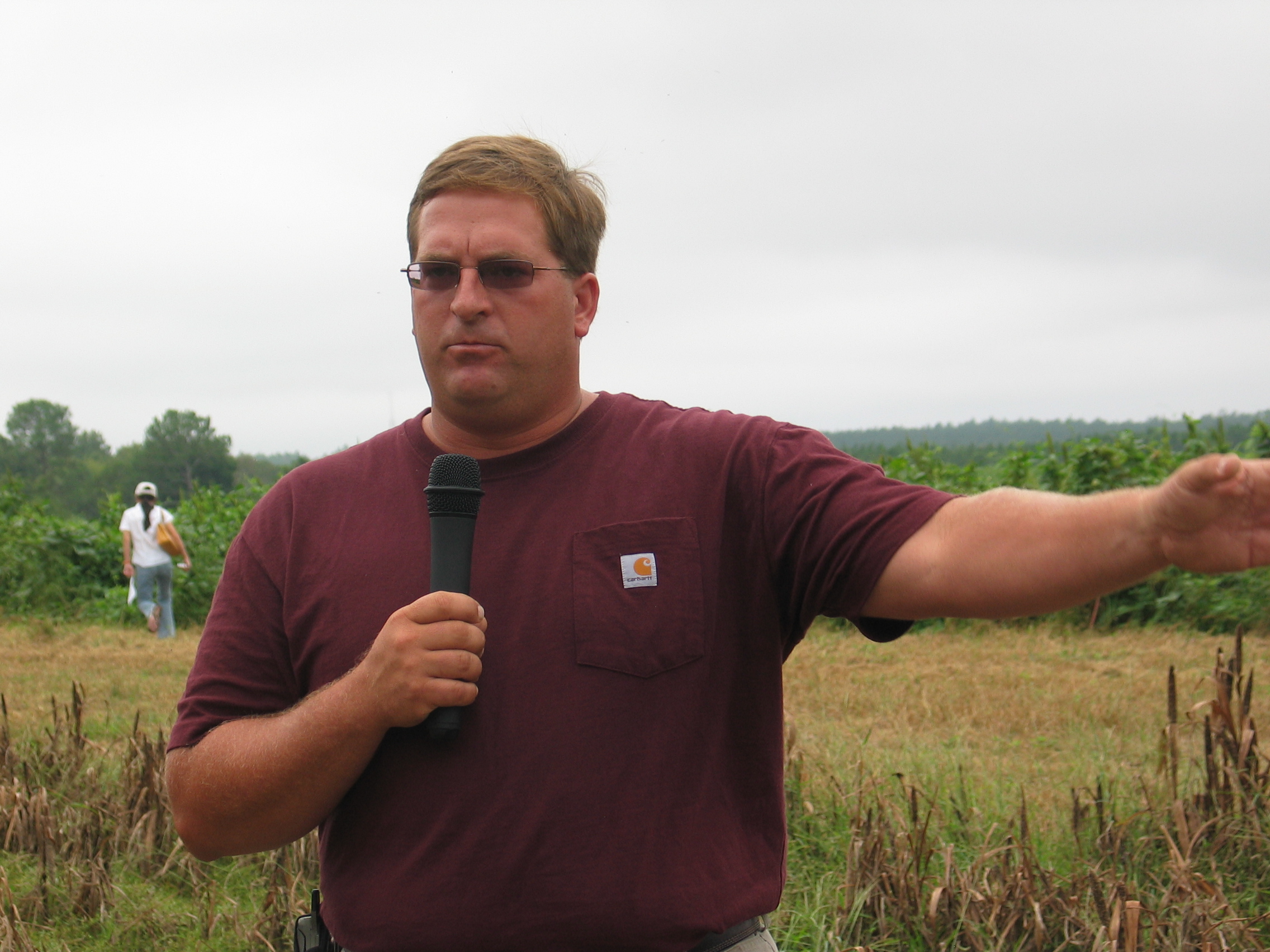 Wednesday during the Georgia Peanut Tour attendees were able to visit with Chris Martin, a farmer in Pulaski County. Martin is trying his hand at growing organic peanuts on a small scale. He has been very successful in the past at growing low input conservation till peanuts so the next step for him to try is organic peanut production. The majority of organic peanuts are produced in Texas and New Mexico, but these states are unable to meet the growing demand. The Georgia climate is excellent for growing peanuts, but they have to be sprayed with pesticides to control insects, weeds and diseases due to the hot humid climate. Researchers have been successful in growing organic peanuts in small plots, but needed research at the farm level. Martin prepared the land and agreed to grow 5 acres of organic peanuts on his farm in 2007. He planted 4 acres of variety DP-1 and 1 acre of the variety Georganic. Martin plowed and irrigated the peanuts and did not apply pesticides during the growing season. The yields for the 2007 crop were 3,000 pounds per acre. “The peanuts in the test yielded just as good as my peanuts I sprayed with pesticides,” Martin says. So, now in 2008, he has decided to participate in a three-year Sustainable Agriculture Research & Education (SARE) transition study from conventional to organic peanuts. Martin has received tremendous assistance with this project from his local county Extension agent Ronnie Barrentine and other researchers with the University of Georgia and USDA.
Wednesday during the Georgia Peanut Tour attendees were able to visit with Chris Martin, a farmer in Pulaski County. Martin is trying his hand at growing organic peanuts on a small scale. He has been very successful in the past at growing low input conservation till peanuts so the next step for him to try is organic peanut production. The majority of organic peanuts are produced in Texas and New Mexico, but these states are unable to meet the growing demand. The Georgia climate is excellent for growing peanuts, but they have to be sprayed with pesticides to control insects, weeds and diseases due to the hot humid climate. Researchers have been successful in growing organic peanuts in small plots, but needed research at the farm level. Martin prepared the land and agreed to grow 5 acres of organic peanuts on his farm in 2007. He planted 4 acres of variety DP-1 and 1 acre of the variety Georganic. Martin plowed and irrigated the peanuts and did not apply pesticides during the growing season. The yields for the 2007 crop were 3,000 pounds per acre. “The peanuts in the test yielded just as good as my peanuts I sprayed with pesticides,” Martin says. So, now in 2008, he has decided to participate in a three-year Sustainable Agriculture Research & Education (SARE) transition study from conventional to organic peanuts. Martin has received tremendous assistance with this project from his local county Extension agent Ronnie Barrentine and other researchers with the University of Georgia and USDA.
Martin currently grows green peanuts for Hardy Farms for boiled peanuts. There has been an interest in growing organic peanuts for the boiling market. Consumers are continuing to demand organic foods so several major food companies have made a commitment to buy organic peanuts. There is also a growing demand for organic peanut butter. This may be a great project to try since the price received for organic peanuts is likely to be three times the amount received for farmer stock peanuts.
View video of Chris Martin on the Georgia Peanut Tour.
Peanut CRSP
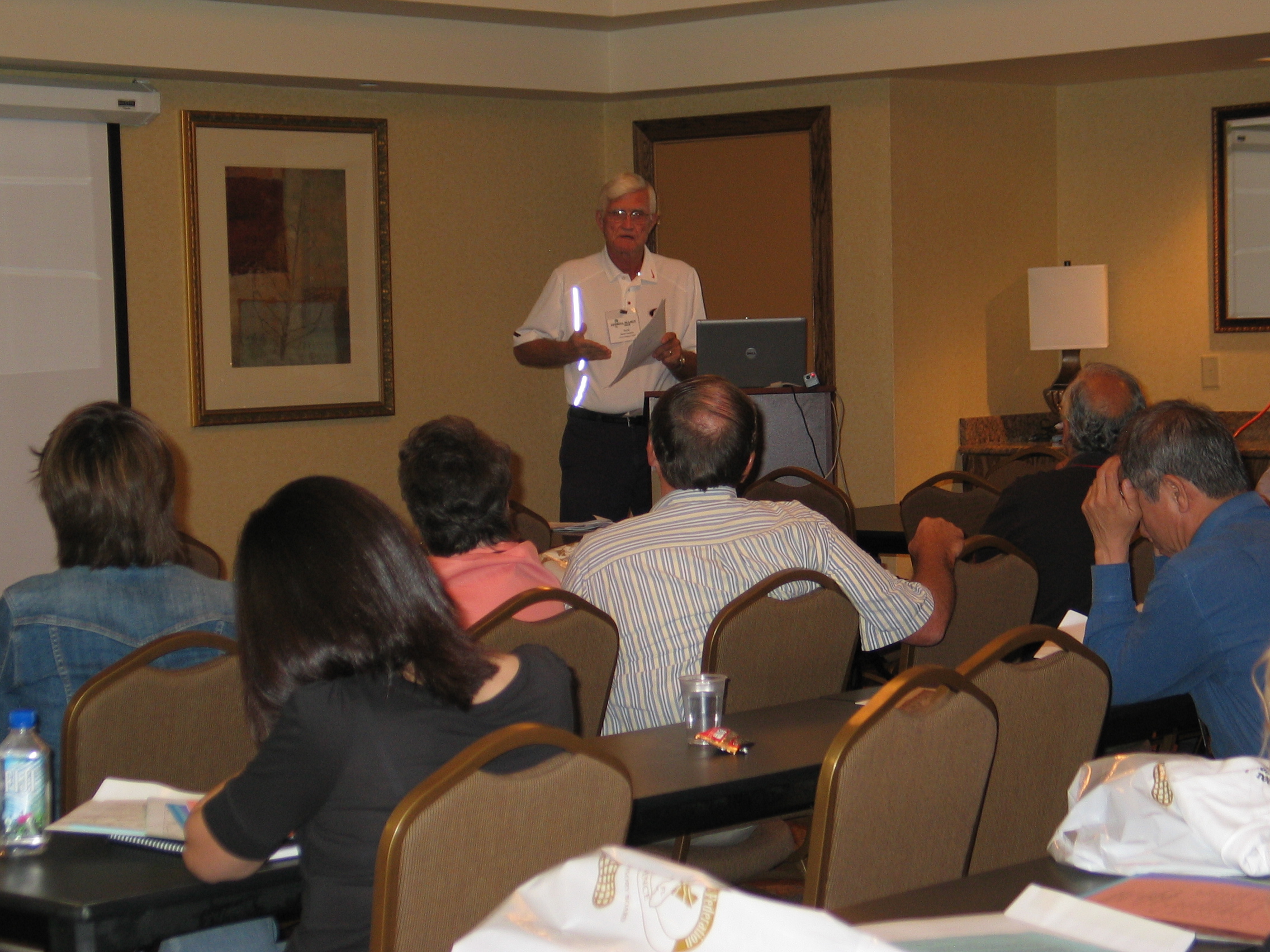 David Cummings presented information on the Peanut Collaborative Research Support Program (CRSP) during the Hot Topics Seminar prior to the tour. The goals of CRSP are to enhance research capability in developing countries and the United States and to focus this capability on the alleviation of major researchable constraints that limit sustainable peanut production and food delivery through an environmentally sound system. The Peanut CRSP has three major research sectors based on priorities across the peanut value chain:
David Cummings presented information on the Peanut Collaborative Research Support Program (CRSP) during the Hot Topics Seminar prior to the tour. The goals of CRSP are to enhance research capability in developing countries and the United States and to focus this capability on the alleviation of major researchable constraints that limit sustainable peanut production and food delivery through an environmentally sound system. The Peanut CRSP has three major research sectors based on priorities across the peanut value chain:
- Producer values – addressing issues that make peanuts more competitive and rewarding for farmers
- Processor values – exploiting opportunities to add greater values to peanuts through processing and market development
- Consumer values – increasing the flavor, nutritional and health-promoting values of peanuts as a component of the diet
The Peanut CRSP is a program supported by the United States Agency for International Development (USAID), US universities, and developing country institutions.
Substantial technical and economic advancement has occurred in many host countries because of collaborative research between U.S. and national scientists. The USA’s peanut industry also presently benefits by at least 10 dollars for each dollar invested in the Peanut CRSP, based on variety releases alone. Future benefits to US agriculture will increase due to new technologies such as the development of virus resistances in the pipeline, and the basic research coming to fruition on aflatoxin.
The program involves 10 U.S. States, 13 Universities and 16 nations from 4 continents. For additional information visit the Peanut CRSP Web site.
GA Peanut Tour Visits Cook Industrial Electirc
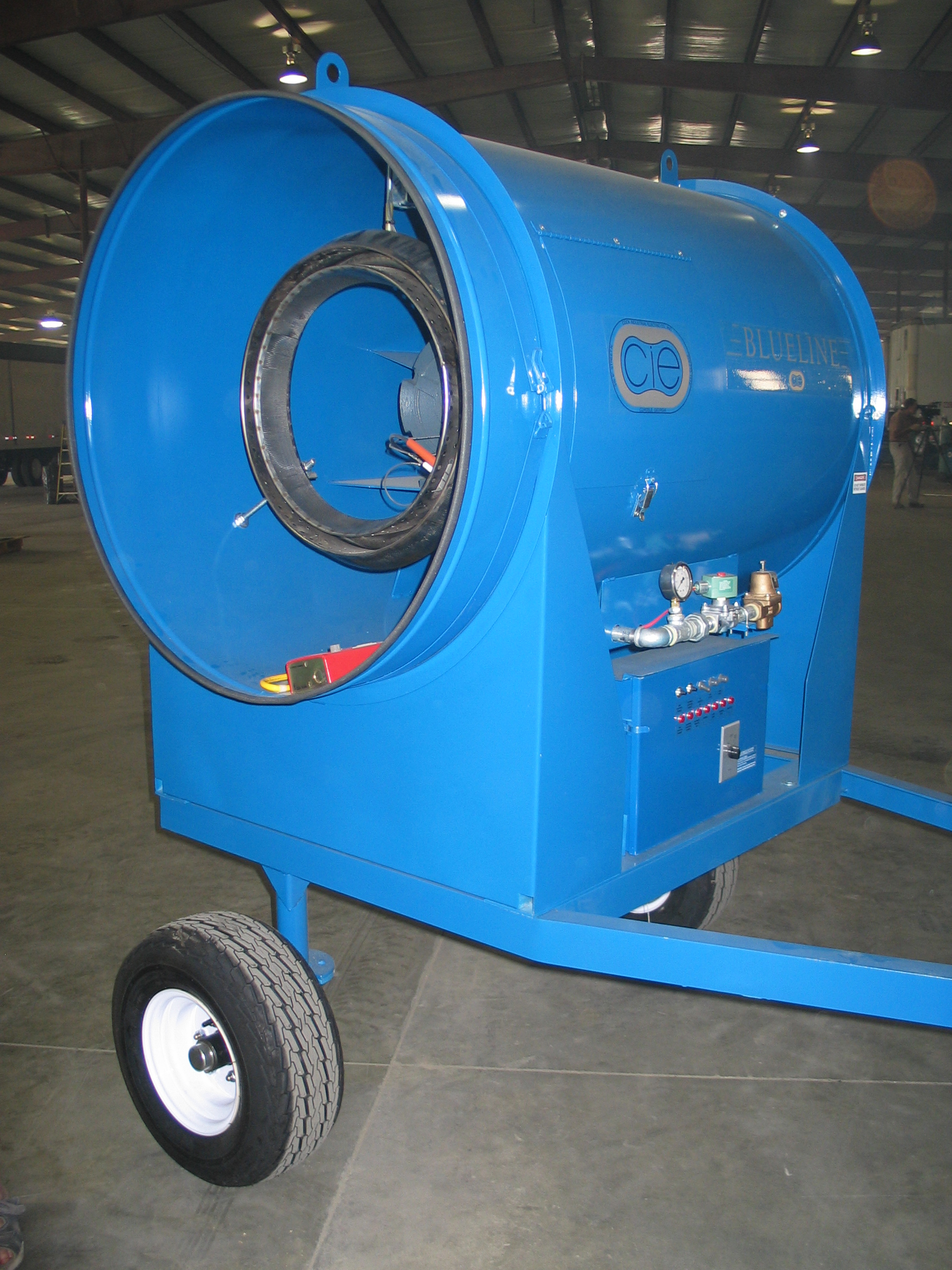 The Georgia Peanut Tour attendees also learned about Cook Industrial Electric Company’s operation in Vienna, Ga. while visiting Advanced Trailers headquarters. Cook Industrial Electric Company has been serving the businesses of Southwest Georgia since the early 1960’s. While agriculture has seen dramatic technological and economic changes Cook Industrial has remained faithful to their original philosophy: to fairly provide our customers with products and services that will maximize productivity and minimize downtime. Known for their Blueline Peanut and crop dyers, Cook Industrial Electric has evolved into a highly diversified company that is rarely found in a rural area such as southwest Georgia. Their Blueline dryer is a simple design and operation, energy-efficient and trouble-free. This industrial dryer helps peanut farmers increase their production numbers while lowering the operating costs. In addition, peanuts that have been through a Blueline dryer have a higher quality. To learn more about the Cook Industrial Electric Company, visit their Website.
The Georgia Peanut Tour attendees also learned about Cook Industrial Electric Company’s operation in Vienna, Ga. while visiting Advanced Trailers headquarters. Cook Industrial Electric Company has been serving the businesses of Southwest Georgia since the early 1960’s. While agriculture has seen dramatic technological and economic changes Cook Industrial has remained faithful to their original philosophy: to fairly provide our customers with products and services that will maximize productivity and minimize downtime. Known for their Blueline Peanut and crop dyers, Cook Industrial Electric has evolved into a highly diversified company that is rarely found in a rural area such as southwest Georgia. Their Blueline dryer is a simple design and operation, energy-efficient and trouble-free. This industrial dryer helps peanut farmers increase their production numbers while lowering the operating costs. In addition, peanuts that have been through a Blueline dryer have a higher quality. To learn more about the Cook Industrial Electric Company, visit their Website.
GA Peanut Tour visits Advanced Trailers
 Georgia Peanut Tour attendees visited Vienna, Ga., home of the 80,000-Square-Foot Advanced Tralier’s Fabrication Shop. Tour members had the opportunity to tour the Advanced Trailer’s facility and learn about their new and upcoming technology that is sweeping peanut farmers’ off their feet. This West Texas invention converts heavy-duty railroad trailers into state-of-the-art drying units, capable of handling more peanuts than the traditional drying wagon, saving farmers’ time and money. Advanced trailers has been in business since 1995 and built its first fully-converted trailer for drying peanuts in 2002. While this latest revolution to roll through the peanut industry may have begun in the heart of West Texas’ peanut fields, today its epicenter is located in Dooly County, Ga. Learn more about Advanced Trailers online at their Web site.
Georgia Peanut Tour attendees visited Vienna, Ga., home of the 80,000-Square-Foot Advanced Tralier’s Fabrication Shop. Tour members had the opportunity to tour the Advanced Trailer’s facility and learn about their new and upcoming technology that is sweeping peanut farmers’ off their feet. This West Texas invention converts heavy-duty railroad trailers into state-of-the-art drying units, capable of handling more peanuts than the traditional drying wagon, saving farmers’ time and money. Advanced trailers has been in business since 1995 and built its first fully-converted trailer for drying peanuts in 2002. While this latest revolution to roll through the peanut industry may have begun in the heart of West Texas’ peanut fields, today its epicenter is located in Dooly County, Ga. Learn more about Advanced Trailers online at their Web site.
Tour of Dawson Brothers Farm
The 150 attendees on the Georgia Peanut Tour began Wed. morning with a visit at Dawson Brothers Farm in Pulaski. This family farm started with 100 acres in the late 1800s. Since that time the farm has continued to expand to 8,000 acres today. Brothers, Rodney Dawson, John Dawson, Jr. and Gary Dawson, are the fourth generation to farm the land in Pulaski County. The diverse farming operation consists of 1,900 acres of peanuts, 5,500 acres of cotton, 1,000 acres of soybeans, 1,200 acres of wheat, 300 acres of watermelon and 300 acres of corn. To help manage their peanut crop the Dawson brothers have been utilizing a Peanut Intensive Management Program developed by their local county extension agent Ronnie Barrentine. Through this program they use Irrigator Pro to schedule their irrigation, monitor their fungicide sprays for disease, monitor their soil temperature and hire a scout to check to for insects. The family also utilizes new technology on their farm including GPS and RTK to help when planting, spraying and harvesting their crops. RTK is a process where GPS signal corrections are transmitted in real time from a reference receiver at a known location to one or more remote rover receivers. This allows peanut farmers the ability to mark their rows when planting peanuts and then be able to find the rows when it is time for digging the peanuts at harvest. As the peanut plant grows the leaf canopy covers the ground to where it is almost impossible to see where the rows are. By using RTK the tractor is able to stay on the actual row and help prevent loss from digging off of the row.
Peanut Butter Medicine saves lives in Haiti
During the Hot Topics Seminar Dr. Patricia Wolff, clinical professor of pediatrics at the Washington University School of Medicine and head of Med & Food for Kids (MFK), discussed a life saving peanut butter medicine for malnourished children in Haiti. The MFK is saving lives of toddlers in Haiti with an innovative mixture of peanuts, powdered milk, sugar, oil, vitamins and minerals. This product is called Ready-to-Use Therapeutic Food (RUTF) and needs no cooking or preparation time. The best part of this product is that toddlers can eat RUTF at home. This allows families to help their children at home instead of having to wait in the hospital. Malnutrition is typically treated at hospitals and feeding centers. It is difficult for parents struggling to feed themselves to commit to the lengthy program available at hospitals, and many families drop out. The home based RUTF can rapidly put weight on a child and costs less than hospitalization and decreases child mortality rates. In fact the product leads to recovery rates that often exceed 85%. The RUTF product is produced right in Haiti under the brand name, Medika Mamba (Haitian Creole for “Peanut Butter Medicine”). Since 2003, MFK has offered the hope of recovery to thousands of malnourished children. Check out the Meds for Kids Web site.

